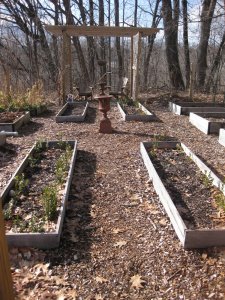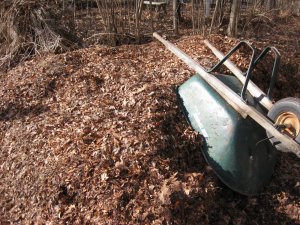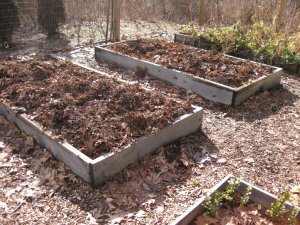Last updated on December 2nd, 2011

Here at a Garden for the House, Monday’s high of 56 degrees (accompanied by two inches of rain and 40 mph winds) melted — in a matter of hours — every trace of snow. I’m taking advantage of this winter-reprieve by topping-off the raised, timber-framed beds in my Kitchen Garden. You see, over the last year the soil in them has become so settled that the beds are now only half-full. Let me show you the symphony of carbon and nitrogen I use for refilling the beds:
 I keep a pile of shredded leaves next the Kitchen Garden, and use this nutrient-rich product to replenish my beds each year. To hasten decomposition, the leaves are sprinkled with one cup of dried blood meal. Blood meal contains about 12% nitrogen, which, when combined with carbon (leaves), produces the heat that turns organic matter into compost.
I keep a pile of shredded leaves next the Kitchen Garden, and use this nutrient-rich product to replenish my beds each year. To hasten decomposition, the leaves are sprinkled with one cup of dried blood meal. Blood meal contains about 12% nitrogen, which, when combined with carbon (leaves), produces the heat that turns organic matter into compost.
 Of course, my every minute spent hauling leaves to the Kitchen Garden now will be thoroughly repaid in spring and summer. For both vegetables and flowers flourish in this composted component we should properly call “leaf mold.”
Of course, my every minute spent hauling leaves to the Kitchen Garden now will be thoroughly repaid in spring and summer. For both vegetables and flowers flourish in this composted component we should properly call “leaf mold.”
Now I’m off to the leaf pile, where both pitch folk and wheelbarrow await. Two boxes were filled yesterday…and I have ten more to go!
Don’t miss a beat at A Garden for the House…sign up for Kevin’s weekly newsletter.
Related Posts:
Leaves, Leaves, Beautiful Leaves
How To Make Your Own Potting Soil
A Virtual Tour of the Kitchen Garden

Randy J says
Kevin,
In the little warm spell that we had last week I loaded up the beds in my Veggie garden with leaves. I'll still need to top off with soil in the spring as last year was the first year for the garden and the soil in the beds settled quite a bit. Thanks for the tip regarding adding blood meal. I'll run out and pick some up.
Kevin Lee Jacobs says
Randy – If you sprinkle your leaves with blood meal now, during winter, you probably won't need any additional top soil in the spring.
I pile my shredded material higher than the rims of the beds, which allows for setting during the composting process.
Sally says
Just curious: could you use straw and blood meal (or another nitrogen source) instead shredded leaves to replenish the beds?
Adele says
You are so lucky to be able to work outdoors today! I can't even see my veggie patch for all the snow!
Kevin Lee Jacobs says
Sally – If I didn't have leaves, I would certainly use straw. Better still; I'd use salt-hay substitute, because its virtually weed-free.
Adele – This fair weather is only temporary, I am sure. But I'm taking advantage of it while I can. I just returned from the Kitchen Garden, having completed all but 2 beds. Manana, as they say.
Eric says
Kevin, I hope you are able to complete your mission by Thursday. Friday's forecast calls for 17 degrees/day, and 8 degrees/night. Ditto for Saturday. Then back to our usually scheduled 20s and teens for the next week!
Kevin Lee Jacobs says
Eric – thanks for the weather report! I'd better finish my last two boxes tomorrow. Otherwise, I don't want spring weather until…spring!
Tammy says
Kevin, is there a good alternative to blood meal? We're vegetarian and try to avoid animal by-products wherever possible.
Kevin Lee Jacobs says
Tammy – useful alternatives to dried blood meal are alfalfa meal, 2.5% nitrogen; and soybean meal, 7% nitrogen. Unfortunately, these are not always easy to find, at least in my neck of the woods.
I should probably mention that leaves do not require the addition of nitrogen to become leaf mold. Kept moist and well-aerated, they naturally reach this fine, crumbly state in two year's time. Nitrogen simply speeds things along.
Tammy says
Kevin, that's very helpful, thanks. I've used leaf mold for years without the addition, so maybe I'll keep at it while I look for the additions you listed.
You are such a kind resource — I'm grateful to have found your site.
Kevin Lee Jacobs says
Tammy – you are welcome. Thanks for reading!
Joyce DeVoe says
Hi, I have been reading your advise about shredded leaves being put on the garden. I now have a community garden plot and would like to use my leaves. I like the idea of free and put what you can to good use. We have oak leaves. Would these be good? How do you shred them. Would I need to purchase a shredder?
I live on cape cod and last year put seaweed, again free and recycled, onto my garden. Would the above suggestions be good for speeding up the decomposition for the seaweed? I also put newspaper down before the seaweed and then some homemade compost. All is organic. Suggestions?
Joyce
Kevin Lee Jacobs says
Hi Joyce – I think dried seaweed is considered carbon, just as leaves are. So you can speed up the decomposition by adding nitrogen. These days I use cottonseed- or alfalfa-meal. Both are terrific sources of organic nitrogen.